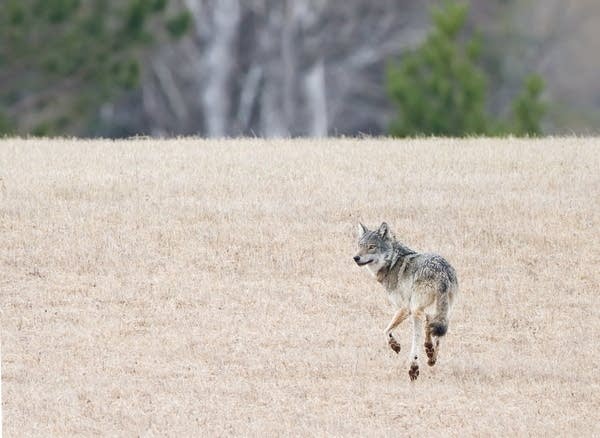Minn. wolf population down since '08, but DNR says it's still strong
Go Deeper.
Create an account or log in to save stories.
Like this?
Thanks for liking this story! We have added it to a list of your favorite stories.

Minnesota's wolf population has dropped by about 24 percent since 2008, according to new survey numbers released Tuesday by the state Department of Natural Resources.
The new numbers likely mean fewer wolves will be allowed to be killed during the next hunting season this fall and winter, said Dan Stark, the DNR's large carnivore specialist. Despite new survey numbers showing the state had an estimated 2,211 wolves last winter, or 710 fewer than five years ago, Stark said the state's wolf population remains strong.
• Today's Question: Do dropping numbers of wolves in Minnesota change your view on the hunt?
Turn Up Your Support
MPR News helps you turn down the noise and build shared understanding. Turn up your support for this public resource and keep trusted journalism accessible to all.
"The wolf population is still widely distributed, and we've actually seen some slight range expansion," he said. "We still have a robust wolf population here in Minnesota, and we can manage a regulated hunting and trapping season without having a long-term negative influence on the population."
Last year during the state's inaugural hunting season, the DNR allowed about 400 wolves, or 13 percent of the previous population estimate, to be killed. Stark said the DNR is still finalizing plans for the next hunting season, but he said it will be similar, meaning the overall quota would go down. The DNR expects to announce details on the season later this month.
Because the wolf survey was performed after the hunt but before pups were born in the spring, DNR researchers estimate that the hunt lowered the population by about 400. But John Erb, a DNR research biologist said more data is needed before he can analyze the full impact the hunt had on the population. Researchers don't know how many of the estimated 2,600 wolf pups born this spring will survive. And the population of deer, wolves' primary prey, has declined in recent years, which can also affect the wolf population.
"The response of a population can really be a function of the survival rate of the pups, and the deer density," Erb said. "We think wolves are a very resilient population. ... Time will tell, and we will continue to monitor and make sure we have confidence in where the population is going, but I think the population is doing well."
Erb said deer density is down about 20 percent, so researchers believe the wolf population was down even before the hunting season.
Stark and Erb said the DNR will continue to use radio collars to monitor the wolf population. Another population survey is planned for next winter.
Several advocacy groups have opposed a wolf hunting season in Minnesota, and on Tuesday at least one of the groups said the new numbers should give officials reason to prevent a second hunt.
Maureen Hackett, executive director of Howling for Wolves, said the DNR's survey does not provide enough information about the full impact of last year's hunt. She said if the hunt prevented some of the 400 wolves killed in the hunt from reproducing or caused packs to break up, the number of wolf pups born this spring could be greatly reduced, causing the overall population to decline further.
Hackett said she hopes officials will reconsider the state's wolf hunting season.
"There is no scientific reason to hunt wolves," Hackett said. "We call on the DNR to refocus on their original management goals for wolves, which are to ensure the long-term survival of the wolf in Minnesota, and to resolve conflicts between wolves and humans."
A lawsuit filed in Minnesota to stop the wolf hunt was unsuccessful, but a larger federal lawsuit filed earlier this year against the U.S. Fish and Wildlife Service for removing gray wolves from the endangered species list is still pending.
Dear reader,
Political debates with family or friends can get heated. But what if there was a way to handle them better?
You can learn how to have civil political conversations with our new e-book!
Download our free e-book, Talking Sense: Have Hard Political Conversations, Better, and learn how to talk without the tension.




